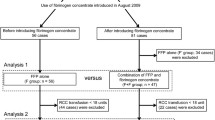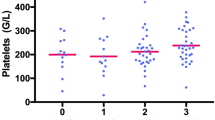Abstract
Japanese obstetrical hemorrhage recommendations state that not only pregnant women with an obstetrical disseminated intravascular coagulation (DIC) score ≥ 8 points but also those with fibrinogen levels ≤ 1.5 g/L have a high risk of maternal death and warrant blood transfusion. Our aim was to demonstrate the potential of fibrinogen levels ≤ 1.5 g/L as predictors of a Japanese obstetrical DIC score of ≥ 8. We included 595 participants with blood loss ≥ 1000 mL during vaginal delivery or ≥ 2000 mL during cesarean delivery. The frequency and volume of red blood cell (RBC), fresh-frozen plasma, platelet concentrate (PC), and fibrinogen administration in women with a DIC score of ≥ 8 and fibrinogen levels of ≤ 1.5 g/L were significantly higher than controls (P < 0.0001). Multivariate analysis demonstrated that a score of ≥ 3 was associated with RBC or fibrinogen administration and a score of ≥ 5 was associated with PC transfusion. Fibrinogen levels ≤ 1.89 g/L and ≤ 2.44 g/L were associated with PC transfusion and fibrinogen administration, respectively. Fibrinogen levels ≤ 1.5 g/L may have similar potential to a DIC score of ≥ 8 points for detecting obstetrical DIC in Japan.

Similar content being viewed by others
Abbreviations
- APTT:
-
Activated partial thromboplastin time
- CI:
-
Confidence interval
- DIC:
-
Disseminated intravascular coagulation
- FDP:
-
Fibrin-fibrinogen degradation product
- FFP:
-
Fresh-frozen plasma
- OR:
-
Odds ratio
- PC:
-
Platelet concentrate
- PT:
-
Prothrombin time
- RBC:
-
Red blood concentrate
- SI:
-
Shock index
References
Minakami H, Maeda T, Fujii T, Hamada H, Iitsuka Y, Itakura A, et al. Guidelines for obstetrical practice in Japan: Japan Society of Obstetrics and Gynecology (JSOG) and Japan Association of Obstetricians and Gynecologists (JAOG). 2014 edition. J Obstet Gynaecol Res. 2014;40(6):1469–99. https://doi.org/10.1111/jog.12419.
Guidelines for obstetrical practice in Japan: Japan Society of Obstetrics and Gynecology (JSOG) and Japan Association of Obstetricians and Gynecologists (JAOG). 2020 edition. in Japanese.
Hasegawa J, Katsuragi S, Tanaka H, Kurasaki A, Nakamura M, Murakoshi T, et al. Decline in maternal death due to obstetric haemorrhage between 2010 and 2017 in Japan. Sci Rep. 2019;9(1):11026. https://doi.org/10.1038/s41598-019-47378-z.
The Japan Association of Obstetricians and Gynecologists (JAOG) and the Japan Maternal Death Exploratory Committee (JMDEC). (ed.) Recommendations for saving mother, (Tokyo, 2018). In Japanese.
Kobayashi T. Obstetrical disseminated intravascular coagulation score. J Obstet Gynaecol Res. 2014;40(6):1500–6. https://doi.org/10.1111/jog.12426.
Terao T, Maki M, Ikenoue T. A prospective study in 38 patients with abruptio placentae of 70 cases complicated by DIC. Asia Oceania J Obstet Gynaecol. 1987;13(1):1–13. https://doi.org/10.1111/j.1447-0756.1987.tb00001.x.
Wang L, Matsunaga S, Mikami Y, Takai Y, Terui K, Seki H. Pre-delivery fibrinogen predicts adverse maternal or neonatal outcomes in patients with placental abruption. J Obstet Gynaecol Res. 2016;42(7):796–802. https://doi.org/10.1111/jog.12988.
Cunningham FG, Leveno KJ, Bloom SL, Dashe JS, Hoffman BL, Casey BM, et al. Williams Obstetrics, 24 ed. Section 11. Chapter 41. Obstetrical Hemorrhage. Placental Abruption. Consumptive Coagulopathy. New York, USA: McGraw-Hill Education. 2014.
Miyata S, Itakura A, Ueda Y, Usui A, Okita Y, Oonishi Y, et al. Transfusion guidelines for patients with massive bleeding. J Transfus Cell Ther. 2019;65(1):21–92. https://doi.org/10.3925/jjtc.65.21 (In Japanese).
Takeda S, Makino S, Takeda J, Kanayama N, Kubo T, Nakai A, et al. Japanese clinical practice guide for critical obstetrical hemorrhage (2017 revision). J Obstet Gynaecol Res. 2017;43(10):1517–21. https://doi.org/10.1111/jog.13417.
Kobayashi T, Terao T, Maki M, Ikenoue T. Diagnosis and management of acute obstetrical DIC. Semin Thromb Hemost. 2001;27(2):161–7. https://doi.org/10.1055/s-2001-14076.
Maki M, Terao T, Ikenoue T, Takemura T, Sekiba K, Shirakawa K, et al. Clinical evaluation of antithrombin III concentrate (BI 6.013) for disseminated intravascular coagulation in obstetrics Well-controlled multicenter trial. Gynecol Obstet Invest. 1987;23(4):230–40. https://doi.org/10.1159/000298866.
Kobayashi T, Kajiki M, Nihashi K, Honda G. Surveillance of the safety and efficacy of recombinant human soluble thrombomodulin in patients with obstetrical disseminated intravascular coagulation. Thromb Res. 2017;159:109–15. https://doi.org/10.1016/j.thromres.2017.08.017.
Yoshihara M, Uno K, Tano S, Mayama M, Ukai M, Kondo S, et al. The efficacy of recombinant human soluble thrombomodulin for obstetric disseminated intravascular coagulation: a retrospective study. Crit Care. 2015;19:369. https://doi.org/10.1186/s13054-015-1086-3.
Tanaka H, Katsuragi S, Osato K, Hasegawa J, Nakata M, Murakoshi T, et al. Efficacy of transfusion with fresh-frozen plasma:red blood cell concentrate ratio of 1 or more for amniotic fluid embolism with coagulopathy: a case-control study. Transfusion. 2016;56(12):3042–6. https://doi.org/10.1111/trf.13856.
Kobayashi T, Nakabayashi M, Yoshioka A, Maeda M, Ikenoue T. Recombinant activated factor VII (rFVIIa/NovoSeven®) in the management of severe postpartum haemorrhage: initial report of a multicentre case series in Japan. Int J Hematol. 2012;95(1):57–63. https://doi.org/10.1007/s12185-011-0974-9.
Murakami M, Kobayashi T, Kubo T, Hata T, Takeda S, Masuzaki H. Experience with recombinant activated factor VII for severe post-partum hemorrhage in Japan, investigated by Perinatology Committee, Japan Society of Obstetrics and Gynecology. J Obstet Gynaecol Res. 2015;41(8):1161–8. https://doi.org/10.1111/jog.12712.
Asakura H. Classifying types of disseminated intravascular coagulation: clinical and animal models. J Intensive Care. 2014;2(1):20. https://doi.org/10.1186/2052-0492-2-20.
Taylor FB Jr, Toh CH, Hoots WK, Wada H, Levi M, Scientific Subcommittee on Disseminated Intravascular Coagulation (DIC) of the International Society on Thrombosis and Haemostasis (ISTH). Towards definition, clinical and laboratory criteria, and a scoring system for disseminated intravascular coagulation. Thromb Haemost. 2001;86(5):1327–30.
Erez O, Novack L, Beer-Weisel R, Dukler D, Press F, Zlotnik A, et al. DIC score in pregnant women-a population based modification of the International Society on Thrombosis and Hemostasis score. PLoS ONE. 2014;9(4):e93240. https://doi.org/10.1371/journal.pone.0093240.
Rabinovich A, Abdul-Kadir R, Thachil J, Iba T, Othman M, Erez O. DIC in obstetrics: Diagnostic score, highlights in management, and international registry-communication from the DIC and Women’s Health SSCs of the International Society of Thrombosis and Haemostasis. J Thromb Haemost. 2019;17(9):1562–6. https://doi.org/10.1111/jth.14523.
Matsunaga S, Takai Y, Seki H. Fibrinogen for the management of critical obstetric hemorrhage. J Obstet Gynaecol Res. 2019;45(1):13–21. https://doi.org/10.1111/jog.13788.
Makino S, Takeda S, Kobayashi T, Murakami M, Kubo T, Hata T, et al. National survey of fibrinogen concentrate usage for post-partum hemorrhage in Japan: investigated by the Perinatology Committee, Japan Society of Obstetrics and Gynecology. J Obstet Gynaecol Res. 2015;41(8):1155–60. https://doi.org/10.1111/jog.12708.
Matsunaga S, Takai Y, Nakamura E, Era S, Ono Y, Yamamoto K, et al. The clinical efficacy of fibrinogen concentrate in massive obstetric haemorrhage with hypofibrinogenaemia. Sci Rep. 2017;7:46749. https://doi.org/10.1038/srep46749.
Acknowledgements
The authors would like to thank Enago (www.enago.jp) for the English language review.
Funding
The first author received funding from Japan Blood Products Organization.
Author information
Authors and Affiliations
Contributions
MM wrote the manuscript and researched data. MM, SM, SM, YT, HH, MN, and MS collected data. AI, TA, and TK contributed to the discussion and reviewed or edited the manuscript.
Corresponding author
Ethics declarations
Conflict of interest
None of the authors have any conflicts of interest to disclose.
Additional information
Publisher's Note
Springer Nature remains neutral with regard to jurisdictional claims in published maps and institutional affiliations.
About this article
Cite this article
Morikawa, M., Matsunaga, S., Makino, S. et al. Effect of hypofibrinogenemia on obstetrical disseminated intravascular coagulation in Japan in 2018: a multicenter retrospective cohort study. Int J Hematol 114, 18–34 (2021). https://doi.org/10.1007/s12185-021-03119-5
Received:
Revised:
Accepted:
Published:
Issue Date:
DOI: https://doi.org/10.1007/s12185-021-03119-5




